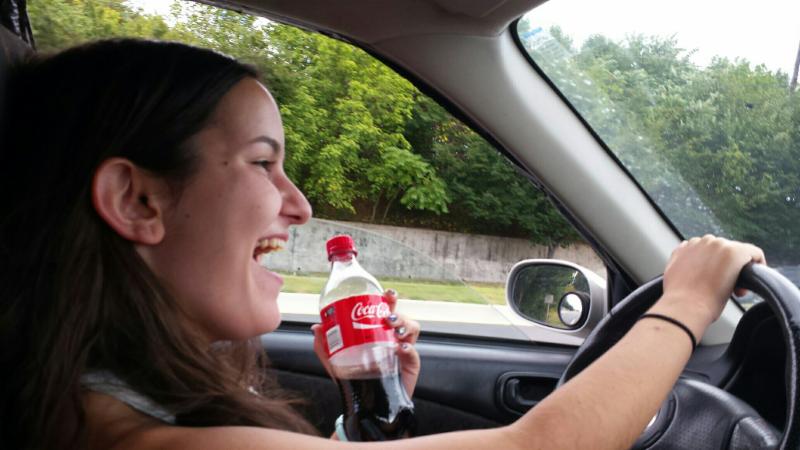 I was driving my daughter Katie when she was about six years old. Along the way — with a facial expression that communicated “I am very upset” — she exclaimed, “Why are you drinking that?”
I was driving my daughter Katie when she was about six years old. Along the way — with a facial expression that communicated “I am very upset” — she exclaimed, “Why are you drinking that?”
It was true that in the afternoons, when I was feeling exhausted, I sometimes drank Coca-Cola. It would give me a much-needed boost to make it through the remainder of the day. It was hard juggling a career, three kids, and a busy household. I explained to Katie that although the sugared and caffeinated drink was not healthy, it was helpful so that I could drive safely. I felt guilty, but what else could I say?
I could tell that my answer didn’t win her over. Since Katie was my third child, and since I work with employees who are often unhappy, I admit that I was accustomed to giving unsatisfactory answers. I didn’t think much more about it.
A few days later, I brewed a cup of my favorite herbal tea, Bengal Spice, and savored the strong cinnamon aroma. I was looking forward to sipping it on the way to a client’s office. Before backing out of the driveway, I carefully placed my 16-ounce white thermal mug in the cup holder and put on my seat belt.
Katie, from the backseat, piped up, “Why did you bring that in the car?”
It was rather full indeed, and perhaps I had made a mistake in not taking time to find a lid. After all, it was likely that some of it would spill, but with 16 ounces I would still have plenty to drink. Plus the car was getting older, and it was nothing that a Clorox wipe couldn’t handle.
I told Katie that if it spilled, we had wipes and I would clean it up. In the meantime, I was enjoying the scent filling the car. Katie was not pleased with my response, and I was not pleased with her policing the condition of my car. She got out of the car and headed in to school with an attitude.
We didn’t even make it a few days more when I got in the car with an open can of seltzer. This time, Katie, on the verge of tears blurted, “Mom! Why do you keep drinking and driving?”
Finally, a light bulb went off. “Angel,” I said, “What have you been taught about drinking and driving?”
Katie shared with me that she had learned that drinking and driving causes accidents and lost lives. That was about all she knew as a six year old. I gave Katie a mini-lesson on alcohol and its effects. As you can imagine, we both felt great relief after our chat.
Clearly, Katie and I had been miscommunicating and upsetting one another for days. But it wasn’t just because Katie was a young child that the miscommunication occurred. Miscommunication happens in offices, in meetings, in cubicles, all day, every day.
Last week I was coaching a senior leader, Paul, in a government agency when he explained his version of a new department initiative. Paul saw it as a way to further develop his team, to challenge one of his star employees with a stretch assignment, and to uncover some personnel issues that were previously obscured. I left the meeting thinking it was a brilliant move for all concerned.
Within hours, I was working with the director, Sandy, whom the new initiative would impact most significantly. Sandy was furious! She was certain she was being “picked on” due to her lack of tenure with the agency and because she was an over-achiever. She felt that she was being given “the impossible team” to manage, and that her director did not want her to succeed because he hated women. She was headed straight to her EEO office to file a grievance, but luckily she ran into her friend Diane in the hall.
Diane truly was a good friend because after she validated Sandy’s feelings, she encouraged her to stop and think before she went to EEO. Diane encouraged Sandy to wait a few days and calm down and then go back and talk to Paul and share her feelings. Sandy did that and Paul was willing to put his own agenda aside and listen. After a couple of talks and brainstorming, the two decided that white papers coming from that office would have her name which would give her the recognition she deserved. It was a classic example of how communication, coupled with openness and brainstorming, can change perception.
Sometimes, employers and their employees have different intentions. Other times, it’s simple miscommunication. Usually, it’s a bit of both.
I can’t say that I am proud of the way I brushed off Katie and her concerns all those years ago. In our work groups and in our families, when we can see that someone is upset, it serves us and our organizations well to take the time to probe and hear, really hear, the other points of view.
Please take the time to share with me one of your examples of miscommunication, and with autumn upon us, treat yourself to a warm cup of aromatic tea.
Karen





0 Comments